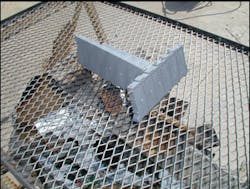During a test burn, the inner plastic cells of the battery, all 26 in this particular case, had melted just like a 12 volt battery will melt down during an engine compartment fire.
Topic: Gasoline-Electric Hybrid Vehicle Fire Testing
When hybrid vehicles first became a reality in the United States, there were many questions about the technology in these unique vehicles. Responders were worried about dealing with these high voltage vehicles. This Crash Course lesson looks at one firefighter field test that was conducted and the lessons that can be learned from this experience.
Through a cooperative effort of an automaker, a Texas fire training academy, and some dedicated safety engineers, this author had the opportunity to conduct some real-world fire tests on a hybrid vehicle and its high-voltage battery.
In one test, fully charged individual cells from a Toyota Prius 274v DC high-voltage battery were set on a grill and exposed to intense fire at a fire academy in Texas. At the time of the testing, no one in the U.S. had ever fire tested a high voltage battery or its' cells so it was anyone's guess as to what would happen.
The fuel for the fire was wood pallets set on fire beneath a suspended mesh grill. The battery cells were placed on the grill. These cells are slender molded plastic units with potassium hydroxide liquid added to the fiber-like filters inside each cell. Once absorbed, the U.S. Department of Transportation classifies the unit as a 'dry cell' battery.
The fire was intense and once extinguished, the cells were essentially intact although obviously melted. There was no fluid leakage. There was no explosion. There was no hazmat incident as some had anticipated.
Next, a fully functional 2001 Toyota Prius gasoline-electric hybrid sedan was placed in position on the burn pad. Newspapers were stuffed around within the engine compartment and ignited with a match. Once again, no one had ever fire tested a gasoline-electric hybrid so there was lots of discussion as to what would or could happen during the fire.
Fire department crews stood by until the vehicle became fully involved. After the peak of the fire had passed and it appeared that the fire was dying down (about 20 minutes of burning), crews made their attack. It took 750 gallons of water to extinguish the fire and overhaul the vehicle.
There was nothing out of the ordinary that occurred during the fire. The windshield melted; the glass in the windows failed. Shocks blew and some tires popped. The driver's airbag made a loud report when it self-detonated. But all in all, nothing unexpected happened.
After everything cooled completely, the high-voltage battery in the trunk was carefully removed and the metal cover taken off to expose the inner battery cells. The inner plastic cells of the battery, all 26 in this particular case, had melted just like a 12 volt battery will melt down during an engine compartment fire. The terminals were still visible and some cells had melted open.
There was no hazmat. There was no leakage of caustic potassium hydroxide. There was nothing unusual about the resulting burnt battery other than reinforcing that responders would never have to ever disassemble a high-voltage battery. Extinguishment was completed with the cover intact simply by applying sufficient flow of water to the battery until it cooled.
Crash Course Teaching Point: Gasoline-electric hybrid vehicle fires can be successfully handled by following the same standard operating procedures used for combating conventional vehicle fires.
Be Informed...Be Ready...Beware!






